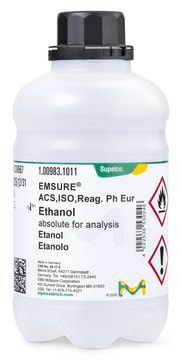32213-M
Metanol
≥99.8% (GC), ACS reagent, suitable for HPLC, reag. Ph. Eur., USP/NF, reag. ISO
Sinónimos:
Alcohol metílico
About This Item
97.68 mmHg ( 20 °C)
Productos recomendados
Nombre del producto
Metanol, puriss. p.a., ACS reagent, reag. ISO, reag. Ph. Eur., ≥99.8% (GC)
grade
ACS reagent
puriss. p.a.
agency
USP/NF
reag. ISO
reag. Ph. Eur.
vapor density
1.11 (vs air)
vapor pressure
410 mmHg ( 50 °C)
97.68 mmHg ( 20 °C)
assay
≥99.8% (GC)
form
liquid
autoignition temp.
725 °F
expl. lim.
36 %
technique(s)
HPLC: suitable
impurities
≤0.00005% free alkali (as NH3)
≤0.0001% formaldehyde
≤0.00025% KMnO4 red. matter (as O)
≤0.0005% non-volatile matter
≤0.001% acetaldehyde
≤0.001% acetone (GC)
≤0.05% water (Karl Fischer)
≤0.1% ethanol (GC)
refractive index
n20/D 1.329 (lit.)
bp
64.7 °C (lit.)
mp
−98 °C (lit.)
density
0.791 g/mL at 25 °C (lit.)
anion traces
chloride (Cl-): ≤0.5 mg/kg
sulfate (SO42-): ≤1 mg/kg
cation traces
Al: ≤0.50 ppm
B: ≤0.02 ppm
Ba: ≤0.10 ppm
Bi: ≤0.10 ppm
Ca: ≤0.50 ppm
Cd: ≤0.05 ppm
Co: ≤0.02 ppm
Cr: ≤0.02 ppm
Cu: ≤0.01 ppm
Fe: ≤0.10 ppm
K: ≤0.50 ppm
Li: ≤0.10 ppm
Mg: ≤0.10 ppm
Mn: ≤0.01 ppm
Mo: ≤0.10 ppm
Na: ≤0.50 ppm
Ni: ≤0.02 ppm
Pb: ≤0.02 ppm
Sn: ≤0.10 ppm
Sr: ≤0.10 ppm
Zn: ≤0.10 ppm
SMILES string
CO
format
neat
InChI
1S/CH4O/c1-2/h2H,1H3
InChI key
OKKJLVBELUTLKV-UHFFFAOYSA-N
¿Está buscando productos similares? Visita Guía de comparación de productos
General description
Application
- Colony forming unit-fibroblast assay of bone marrow mononuclear cells.
- As solvent for the preparation of extracts of hyphae of Aspergillus for the estimation of gliotoxin by reversed phase-HPLC.
- Immunofluorescence studies.
Packaging
Related product
signalword
Danger
Hazard Classifications
Acute Tox. 3 Dermal - Acute Tox. 3 Inhalation - Acute Tox. 3 Oral - Flam. Liq. 2 - STOT SE 1
target_organs
Eyes,Central nervous system
Storage Class
3 - Flammable liquids
wgk_germany
WGK 2
flash_point_f
49.5 °F - closed cup
flash_point_c
9.7 °C - closed cup
Elija entre una de las versiones más recientes:
¿Ya tiene este producto?
Encuentre la documentación para los productos que ha comprado recientemente en la Biblioteca de documentos.
Nuestro equipo de científicos tiene experiencia en todas las áreas de investigación: Ciencias de la vida, Ciencia de los materiales, Síntesis química, Cromatografía, Analítica y muchas otras.
Póngase en contacto con el Servicio técnico





